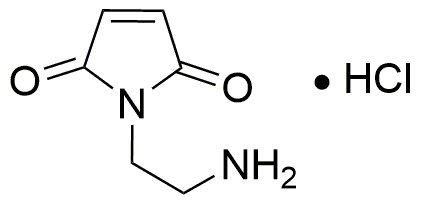N-(2-Aminoethyl)maleimide hydrochloride is widely utilized in research focused on:
- Bioconjugation: This compound is commonly used to attach biomolecules, such as proteins or antibodies, to surfaces or other molecules, enhancing the development of targeted drug delivery systems.
- Diagnostics: It plays a crucial role in the creation of diagnostic assays, particularly in the detection of specific proteins or biomarkers in medical testing.
- Polymer Chemistry: In the field of materials science, it is used to modify polymers, improving their properties for applications in coatings, adhesives, and sealants.
- Cell Biology: Researchers utilize this compound to study cell signaling pathways and interactions, providing insights into cellular functions and disease mechanisms.
- Therapeutic Development: It is being explored for its potential in developing new therapeutic agents, particularly in cancer treatment, due to its ability to selectively target and modify cellular components.
Informations générales
Propriétés
Sécurité et réglementation
Applications
N-(2-Aminoethyl)maleimide hydrochloride is widely utilized in research focused on:
- Bioconjugation: This compound is commonly used to attach biomolecules, such as proteins or antibodies, to surfaces or other molecules, enhancing the development of targeted drug delivery systems.
- Diagnostics: It plays a crucial role in the creation of diagnostic assays, particularly in the detection of specific proteins or biomarkers in medical testing.
- Polymer Chemistry: In the field of materials science, it is used to modify polymers, improving their properties for applications in coatings, adhesives, and sealants.
- Cell Biology: Researchers utilize this compound to study cell signaling pathways and interactions, providing insights into cellular functions and disease mechanisms.
- Therapeutic Development: It is being explored for its potential in developing new therapeutic agents, particularly in cancer treatment, due to its ability to selectively target and modify cellular components.
Documents
Fiches de données de sécurité (FDS)
La FDS fournit des informations de sécurité complètes sur la manipulation, le stockage et l’élimination du produit.
Spécifications du produit (PS)
Le PS fournit une description complète des propriétés du produit, notamment sa composition chimique, son état physique, sa pureté et les exigences de stockage. Il détaille également les plages de qualité acceptables et les applications prévues du produit.
Certificats d'analyse (COA)
Recherchez des certificats d'analyse (COA) en saisissant le numéro de lot du produit. Les numéros de lot et de lot se trouvent sur l'étiquette d'un produit, après les mots « Lot » ou « Lot de fabrication ».
Numéro de catalogue
Numéro de lot/série
Certificats d'origine (COO)
Ce certificat d'exploitation confirme le pays dans lequel le produit a été fabriqué, et détaille également les matériaux et composants utilisés et s'il est issu de sources naturelles, synthétiques ou autres sources spécifiques. Ce certificat peut être requis pour les douanes, le commerce et la conformité réglementaire.
Numéro de catalogue
Numéro de lot/série
Fiches de données de sécurité (FDS)
La FDS fournit des informations de sécurité complètes sur la manipulation, le stockage et l’élimination du produit.
DownloadSpécifications du produit (PS)
Le PS fournit une description complète des propriétés du produit, notamment sa composition chimique, son état physique, sa pureté et les exigences de stockage. Il détaille également les plages de qualité acceptables et les applications prévues du produit.
DownloadCertificats d'analyse (COA)
Recherchez des certificats d'analyse (COA) en saisissant le numéro de lot du produit. Les numéros de lot et de lot se trouvent sur l'étiquette d'un produit, après les mots « Lot » ou « Lot de fabrication ».
Numéro de catalogue
Numéro de lot/série
Certificats d'origine (COO)
Ce certificat d'exploitation confirme le pays dans lequel le produit a été fabriqué, et détaille également les matériaux et composants utilisés et s'il est issu de sources naturelles, synthétiques ou autres sources spécifiques. Ce certificat peut être requis pour les douanes, le commerce et la conformité réglementaire.


